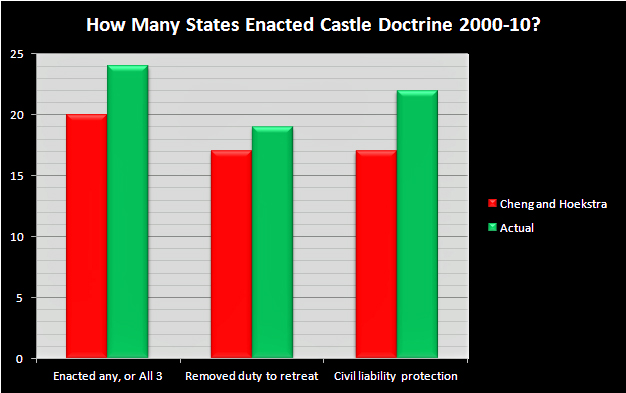By Howard Nemerov
When George Zimmerman shot Trayvon Martin, anti-rights politicians and media saw an opportunity to sway public opinion in favor of repealing state “castle doctrine” laws. All they needed was supportive “research.” Enter Cheng Cheng and Mark Hoekstra, both of the Texas A&M University Economics Department — they published a paper titled “Does Strengthening Self-Defense Law Deter Crime or Escalate Violence? Evidence from Expansions to Castle Doctrine.” They concluded that “castle doctrine” had no beneficial impact on burglary, robbery, and aggravated assault. They also claimed that the result of “strengthening self-defense law is increased homicide.” Their conclusion: enhanced self-defense laws caused more murder . . .
The media ate it up. The Chicago Tribune ran an article titled “Report: ‘Stand Your Ground’ laws lead to increase in homicide.” Think Progress, while covering Alaska governor Sean Parnell’s signing of the state’s new Stand Your Ground law, wrote: “Studies have shown that Stand Your Ground laws are discriminatory, associated with higher homicide rates, and don’t deter crime.”
Had the media actually explored available data themselves, Cheng and Hoekstra’s research would have been marginalized instead of lauded as evidence that “castle doctrine” should be repealed.
What is “castle doctrine”?
“Castle doctrine” laws include three possible enhancements to existing self-defense laws. First: if people are someplace they have the right to be, they’re no longer obligated to attempt flight before using defensive force (Remove Duty to Retreat, also called Stand Your Ground). Second: if attacked, it’s reasonable for the defender to believe their life is at risk (Presumption of Reasonable Fear). Third: it’s much harder for attackers or their estate to sue for damages resulting from justifiable self-defense (Civil Liability Protection).
Not all “castle doctrine” states enact all three enhancements, nor do they necessarily enact them all at once. For example, Alaska had already enacted the second and third enhancements prior to removing the duty to retreat.
Authors’ dataset contains errors and inaccurate assumptions
Cheng and Hoekstra recently published an updated version of their research, yet the authors retained numerous errors from their earlier version, calling into question their methods and motives.
Cheng and Hoekstra compiled a table of 20 states that enacted some or all of these “castle doctrine” laws between 2000 and 2010, but 24 states enacted “castle doctrine” laws during their study period [page 36].
They claimed that Missouri enacted Stand Your Ground and civil protection, but Missouri law includes limited enhancements and shouldn’t be counted. Even so, their dataset contained many other errors. For example, they claimed 17 states removed the duty to retreat during their study period — actually, 19 did. Twenty-two states provide civil liability protection — the authors included only 17 (see graph below). They correctly noted that 13 states enacted Presumption of Reasonable Fear, but they ignored four states that enacted “castle doctrine” laws: Idaho (2006), Maine (2007), Wisconsin (2008), and Wyoming (2008).

(Cheng & Hoekstra [page 7] cited National Rifle Association’s Institute for Legislative Action, as did I)
Another problem with their dataset is that they equate Stand Your Ground with “castle doctrine”:
In 2005, Florida became the first in a recent wave of states to pass laws that explicitly extend castle doctrine to places outside the home, and to expand self-defense protections in other ways. Since then, more than 20 states have followed in strengthening their self-defense laws by passing versions of “castle doctrine” or “stand-your-ground” laws. … For ease of exposition, we subsequently refer to these laws as castle doctrine laws. [page 1]
As shown later in this article, the difference between enacting only Stand Your Ground and full “castle doctrine” is significant when looking at crime trends.
The authors also assumed that enhanced self-defense laws deter non-confrontational crimes like burglary [page 2]. However, property crimes like burglary are more likely to increase when more citizens partake of their civil right of self-defense. In The Bias Against Guns, John Lott explained:
If you make something more difficult, people will be less likely to engage in it … just as grocery shoppers switch between different types of produce depending on costs, criminals switch between different kinds of prey depending on the cost of attacking. Economists call this, appropriately enough, “the substitution effect.”
Instead of violent, confrontational crime like robbery to obtain a victim’s property, criminals wait until victims leave home before committing burglary, which presents less personal risk to themselves.
FBI crime data support Lott’s premise. As more law-abiding citizens arm themselves, violent crimes drop and property crimes rise. Of all FBI major crime categories, only burglary increased between 2000 and 2010 (over 5%). Meanwhile, homicide incidents decreased over 5%, robbery decreased 10%, and aggravated assaults decreased 15%.
Cheng and Hoekstra claimed they wanted to determine “whether strengthening self-defense laws deters criminals,” but including burglary is simply an attempt to derogate “castle doctrine” for doing what it should: causing criminals to commit more property crimes and fewer violent crimes.
The authors altered their own conclusions by beginning with a misleading dataset.
FBI data show that “castle doctrine” correlates with less violent crime, not more
The authors attempted to guess what violent crime rates should have been had “castle doctrine” states not enhanced their self-defense laws by comparing them to non-“castle doctrine” states [page 3].
One way to determine if states benefitted from enhanced self-defense laws is to ask whether violent crime rates increase or decrease after enactment. If rates increased, then enacting “castle doctrine” laws created a “cost” because higher rates meant greater victimization. If rates decreased, then these laws created a “savings” because of less victimization after enactment.
Averaging five or more years together gives a picture of the general level of violence during that time period. For the states in this study, the average year they enacted “castle doctrine” laws was 2006. Including non-enacting states’ performance before and after 2006 provides a comparison to see how well states did without enhanced self-defense laws. This dataset includes “before” years of 2000-2005 and “after” years of 2006-2010. For Stand Your Ground and full “castle doctrine” states, their year of enactment defines “before” and “after” periods, each with their murder, robbery, and aggravated assault rates averaged. If the average crime rate was lower in the “after” period, the state became safer.
The truth? States that adopted all three “castle doctrine” laws experienced the largest declines in all three violent crime rates, handily besting non-adopting states.
Stand Your Ground states (removing Duty to Retreat but not necessarily Civil Immunity Protection and Presumption of Reasonable Fear) averaged larger decreases in murder rates than non-adopting states, too. While their aggravated assaults declined on par with non-adopting states, their robbery rates — while dropping after enactment — declined less than non-adopting states:
 (All crime rates describe the number of victims per 100,000 population)
(All crime rates describe the number of victims per 100,000 population)



These data suggest that Cheng and Hoekstra had a point only if their sole conclusion highlighted the smaller benefits of enacting No Duty to Retreat laws alone. To claim that homicide increased is questionable at best.
Most importantly, Cheng and Hoekstra suggested these laws affect crime rates. If true, the data show adopting all three “castle doctrine” laws causes a noticeable decrease in violent crime.
This article originally appeared at jpfo.org and is reprinted here with permission.





Just repeating what we already know; if people are allowed to exercise their right to self defense, then criminals will no longer have power over them. Criminals are inherently cowardly, and will not stand up to armed citizens.
Looks like the post above me is SPAM
So, the stripping web-cam is working out, eh?
a) I wonder what these methods would show for Miranda, due process, right to bail, requirements for warrants, cruel and unusual prohibitions of life imprisonment for first felony, etc.?
b) I wonder what applying these methods to vaccines would show. Well, actually I know.They would show vaccines as an immensely harmful because the benefit would be severely undercounted relative to the much more solid numbers on harm. Are the study’s authors anti vaccine as well?
See “Rise of the Warrior Cop” By Radly Balko for and even better explination of what Castle Doctrine is and the historical significance of it. It is a lot more than just self defense from criminals. It is also one of the fundamental ways we are supposed to be protected from our government and its propensity toward tyrrany.
As an Aggie I am ashamed of the poor quality research from Cheng and Hoekstra.
An important point about their paper though, is that it is not published and has not been peer reviewed. The peer review process rejects bogus, unethical, falsified, or shoddy research. It also serves to strengthen and clarify the writing so that it has a better impact.
For the media to jump on this unpublished, unreviewed paper and shout joy for their cause is outright cherry-picking (my surprise face). The fact that so many errors have been found in it, demonstrates why it needs peer-review. As such, nothing in the paper can be accepted as remotely significant until such time as it is properly vetted.
Wow- thats an important point about not-published, not-peer-reviewed.
Reflects badly upon A&M and the authors both then…
I’d say same to the majority of newspapers like Chicago Trib, who should know better…but they havent been fair or balanced for some time.
No wonder their credibility is in the toilet and circling lower:
http://pjmedia.com/instapundit/172271/
No Federal grant DOLLARS flow to the “reseacher” who discovers any correct in tradional American values. Certainly the 2nd Amendment. Follow the $.
FUC*&N Aggies!
LOL j/k kind of.
As an Aggie I am ashamed of the poor quality research …For the media to jump on this unpublished, unreviewed paper and shout joy for their cause is outright cherry-picking (my surprise face).
It is incorrect to say it is unpublished.
It is forthcoming.
Then scholars will read it and judge its worthiness. There is no cherry-picking. You clearly are confused.
This blog author is in effect arm-waving, and we’ve seen this very tactic a thousand times before.
Best,
D
I feel the same way Dr. Sheets. It is sad to see the integrity of A&M fall to the hands of people who want to just be known. Also sad to hear that loftin won’t be there next year.
Gig’em
I graduated in 1990. It’s not the same place it used to be.
Great link, Dan, thanks.
Not a statistician, here, so I REALLY appreciate your taking the time to pass on Mr Nemerovs analysis of the details, to present the Truth About the Gun Study.
Also observe from many years in the financial biz when you get ten economists in one room you get eleven opinions…so I am reserving judgement on the debate.
I do wonder who funded this grant, if there was one, attached for the research…
Given how quickly the “progressive” anti-gunners have jumped on it, I’m sure the memo went out right away…
PS: not to quibble, for I appreciate the hat-tip to JPFO, which I find to be a great resource- and would never have found JPFO, but for TTAG, but the original source, per the JPFO page link is actually:
Pajamas Media, same author: http://pjmedia.com/blog/politicized-science-no-castle-doctrine-does-not-increase-violent-crime/
which I point out only because theres a lot of smart posters there, including another (same) “tdiinva”.
Great minds think alike, is my point, and Robt,
btw, apologies for spamming with html,
but doesnt cross-linking increase web-page views and google SEO results?
technically, ten economists 30 opinions. yes but it depends, no but it depends, and a linearized DSGE model calibrated to historical data which conclusively proves that it depends. 😉
If you laid all the economists in the world end to end they still couldn’t reach a conclusion.
“If you lined up all the economists in the country, the line would be pointing in the wrong direction.” #FTFY 😉
Hmmm. posted a longer comment with three links- did I hit the spam filter?
Is that bad, Nick, or Robt? I thought cross-linking helps page count and search results, if it drives eyeballs here- my bad if not.
Anyway- the Point was- hat-tip to Dan for posting this, which came originally from PJ Media- another great site, with some of like minded thinkers posting as here- (hello? tdiinva? )
Thanks Mr Nemorov- great work. Would really like to know who funded the grant, if there was one, for this piece of “work” –
given how fast the memo seemed to go out, to places like “ThinkProgress”.
I like how they stated “studies” show, as in plural. Where are the other studies to back up Hoekstra et al? But nowhere like the “they” that is always the straw man in these anti-gun hoaxes.
Maybe someone’s already mentioned it and I missed it; but the study’s authors address a major point only in passing and in Footnote 6. It deserves further attention because it goes to the heart of their study.
They discuss, briefly, the distinction between SYG and CD being codified in state statutes, as opposed to becoming the de facto law of the land earlier through case law. By focusing on strictly statutory adoption, that therefore defines the time periods in question, the before-and-after duality, and the pools of average annual crime rates to compare, in terms of the average year of statutory adoption. Well.
If a given legal theory, principle, standard, or threshold such as SYG and CD, were introduced previously through case law, albeit piecemeal, and was *already* understood by criminals and defenders alike to be the de facto law of the land, then those principles, standards, etc. would already be in real life effect and incorporated into people’s decisions.
In that case, formal codification of SYG and CD by way of state statutes years later would be more of a technical formality and less of a practical sea change in criminal law. Such would transform the resulting periods of crime rate comparisons from “before-and-after” into something more like “after-and-even-later-after.” That is, passing SYG and CD laws themselves wouldn’t be expected to have as much practical impact, since their passage would take place in an era where their underlying principles were already in effect; having come from case law.
Nice observation.
Great article!
Double negative in the title, so it does increase violence.
In the GZ/TM case, who was being attacked and who was standing their ground? It’s still not clear to me.
Well, Zimmerman had injuries to his face and the back of his head from being struck by Martin. Martin had no injuries except his gunshot wound to the heart. So unless Martin managed to beat Zimmerman after taking a bullet to the heart, Martin initiated the attack.
Of course stand your ground is nice and all that. My state has it. But useless outside the home if you have nothing to stand your ground with.
California has had stand your ground since well before the 20th century, way before Texas, Florida. I love the fact that the San Fran Chronicle defended its attack on Florida’s law by saying, well, yeah California has stand your ground…but that is different, we have had it longer, are used to it, etc…. apparently Floridians are not mature enough for stand your ground, but Californians are….but we generally cannot carry a firearm
Let’s say you enact Law A which you believe will have a beneficial effect on crime. After 5 years you compare the crime levels and notice some decrease. Was Law A really effective itself as a cause of this effect?
Maybe, maybe not. You would also have to take into account the previous trends. If crime had been slowly decreasing for years then you could only assume Law A might have had an effect if the _rate_ of decrease was greater. If crime continued to decline at the same rate as previously then there is no reason to believe the law had any effect.
I have read analysis of the gun buyback in Australia that suggest this was the phenomenon that they tout as the result of that odious experiment in gun control.
lwk
That fallacious study is quoted EVERYWHERE. Just Google it!
The anti-gunners are quick to claim any studies that claim benefits from gun ownership were the product of pro-gun zealots massaging the data. How can we disprove this widely-quoted claim? How can we better convince the media (both pro and anti-gun) to look closer at the data and the researchers’ agenda?
Too bad the sheeple will never bother to understand the difference between Castle Doctrine and SYG laws. And also never bother to actually read said laws to see how specifically narrow the protections really are. Instead, they like milk to a kitten, they lap up what the media puts out there, that these are “shoot first” laws, and accept that as truth. Hell, in a lot of states, heaven forbid you KNOW the person (even a little bit) you ended up shooting, the .gov might just charge you with a crime anyway, even if everything else is cut and dried. In CA, the law can be read to mean that you can NEVER use deadly force on a family member, even in self defense.
Comments are closed.